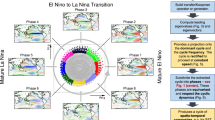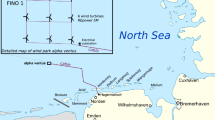Abstract
THE ability to distinguish a warming trend from natural variability is critical for an understanding of the climatic response to increasing greenhouse-gas concentrations. Here we use singular spectrum analysis1 to analyse the time series of global surface air tem-peratures for the past 135 years2, allowing a secular warming trend and a small number of oscillatory modes to be separated from the noise. The trend is flat until 1910, with an increase of 0.4 °C since then. The oscillations exhibit interdecadal periods of 21 and 16 years, and interannual periods of 6 and 5 years. The interannual oscillations are probably related to global aspects of the El Niño-Southern Oscillation (ENSO) phenomenon3. The interdecadal oscillations could be associated with changes in the extratropical ocean circulation4. The oscillatory components have combined (peak-to-peak) amplitudes of >0.2 °C, and therefore limit our ability to predict whether the inferred secular warming trend of 0.005 °Cyr−1 will continue. This could postpone incontrovertible detection of the greenhouse warming signal for one or two decades.
This is a preview of subscription content, access via your institution
Access options
Subscribe to this journal
Receive 51 print issues and online access
$199.00 per year
only $3.90 per issue
Buy this article
- Purchase on Springer Link
- Instant access to full article PDF
Prices may be subject to local taxes which are calculated during checkout
Similar content being viewed by others
References
Vautard, R. & Ghil, M. Physica D35, 395–424 (1989).
Jones, P. D., Wigley, T. M. L. & Wright, P. B. Nature 322, 430–434 (1986).
Rasmusson, E. M., Wang, X.-L. & Ropelewski, C. F. J. mar. Sys. 1, 71–96 (1990).
Bjerknes, J. Adv. Geophys. 10, 1–82 (1964).
Folland, C. K., Parker, D. E. & Kates, F. E. Nature 310, 670–673 (1984).
Hansen, J. & Lebedeff S. J. geophys. Res. 92, 13345–13372 (1987).
Karl, T. R. Clim. Change 12, 179–197 (1988).
Jones, P. D. et al. J. Clim. appl. Met. 25, 1213–1230 (1986).
Bottomley, M., Folland, C. K., Hsiung, J., Newell, R. E. & Parker, D. E. Global Ocean Surface Temperature Atlas (HMSO- UK Meteorological Office and Massachusetts Institute of Technology, 1990).
Houghton, J. T., Jenkins, G. J. & Ephraums, J. T. (eds), Climate Change, the IPCC Scientific Assessment (Cambridge University Press, 1990).
Kuo, C., Lindberg, C. & Thomson, D. J. Nature 343, 709–713 (1990).
Slepian, D. Bell System tech. J. 57, 1371–1429 (1978).
Thomson, D. J. Proc. IEEE 70, 1055–1096 (1982).
Park, J., Lindberg, C. R. & Vernon, F. L. III J. geophys. Res. 92, 12675–12684 (1987).
Yiou, P. et al. in Interaction of the Global Carbon and Climate Systems (eds W. H. Berger & R. Keir) 28, 1–22 (Electric Power Res. Inst., Palo Alto, 1989).
Broomhead, D. S. & King, G. P. Physica D20, 217–236 (1986).
Fraedrich, K. J. atmos. Sci. 43, 419–432 (1986).
Barnett, T. P. & Preisendorfer, R. W. J. atmos. Sci. 35, 1771–1787 (1978).
Ghil, M. & Mo, K. C. J. atmos. Sci. 48, 752–790 (1991).
Folland, C. K. Met. Mag. 112, 163–183 (1983).
Newell, N. E., Newell, R. E., Hsiung, J. & Wu, Z.-X. Geophys. Res. Lett. 16, 311–314 (1989).
Cornish, E. A. Q. J. & R. met. Soc. 62, 481–492 (1936).
Keppenne, C. L. & Ghil, M. in Proc. 15th Climate Diagnostics Workshop, Climate Analysis Center, National Meteorological Centre/National Oceanic and Atmospheric Administration (in the press).
Penland, C., Ghil, M. & Weickmann, K. M. J. geophys. Res. (in the press).
Jones, P. D., Wigley, T. M. L., Folland, C. K. & Parker, D. E. Clim. Monit. 175–185 (1987).
Cane, M. A., Zebiak, S. E. & Dolan, S. C. Nature 321, 827–832 (1986).
Rasmusson, E. M. Am. Scient. 73, 168–177 (1985).
Ghil, M. The Sun in Time (eds C. P. Sonett & M. S. Giampapa), Univ. of Arizona Press (in the press).
Levitus, S. J. geophys. Res. C94, 6091–6131 (1989).
Pan, Y. H. & Oort, A. H. Clin. Dynam. 4, 191–205 (1990).
Author information
Authors and Affiliations
Rights and permissions
About this article
Cite this article
Ghil, M., Vautard, R. Interdecadal oscillations and the warming trend in global temperature time series. Nature 350, 324–327 (1991). https://doi.org/10.1038/350324a0
Received:
Accepted:
Issue Date:
DOI: https://doi.org/10.1038/350324a0
This article is cited by
-
Decadal-scale variability and warming affect spring timing and forest growth across the western Great Lakes region
International Journal of Biometeorology (2024)
-
Imprint of Diurnal and Semidiurnal Cyclicity in Radon Time Series of MPGO, Ghuttu Garhwal Himalaya: Evidence Based on Singular Spectrum Analysis
Pure and Applied Geophysics (2023)
-
Earthquake magnitude prediction in Turkey: a comparative study of deep learning methods, ARIMA and singular spectrum analysis
Environmental Earth Sciences (2023)
-
Complex Systems Methods Characterizing Nonlinear Processes in the Near-Earth Electromagnetic Environment: Recent Advances and Open Challenges
Space Science Reviews (2023)
-
Prediction of the earthquake magnitude by time series methods along the East Anatolian Fault, Turkey
Earth Science Informatics (2021)
Comments
By submitting a comment you agree to abide by our Terms and Community Guidelines. If you find something abusive or that does not comply with our terms or guidelines please flag it as inappropriate.



